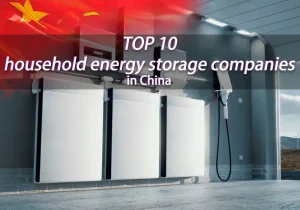Home » battery news » How to choose the battery capacity in household storage
How to choose the battery capacity in household storage?
In recent years, the importance of energy storage to power systems has become increasingly prominent.
The popularization of photovoltaic power generation, the maturity of lithium battery technology and large-scale production also provide key prerequisites for energy storage to enter the homes of ordinary people.
In order to meet the different needs of customers for energy storage systems, energy storage equipment manufacturers have also put forward various solutions based on their strengths.
Top 10 energy storage battery companies in China have launched industrial and commercial energy storage, household energy storage, off-grid energy storage, portable energy storage and other solutions for different application scenarios.

In many households, especially in regions with high electricity prices such as Europe and the United States and regions with unstable electricity such as Africa, energy storage has become a must for energy management.
Energy storage capacity plays a key role in the utilization of household energy or electricity bills, so how to choose a more suitable battery capacity in the configuration of household energy storage systems has become the most concerned and questioned link.
Four common misunderstandings in battery capacity selection
Misunderstanding 1: Choose battery capacity only based on load power and power consumption
In battery capacity design, the load condition is indeed the most important reference factor.
However, the charging and discharging capacity of the battery, the maximum power of the energy storage machine, and the power consumption time of the load cannot be ignored.
Therefore, the battery capacity cannot be selected only by considering the load power and power consumption, but a comprehensive consideration is required.
Misunderstanding 2: Taking the theoretical capacity of the battery as the actual capacity
Usually, the battery manual is marked with the theoretical design capacity of the battery, which is the maximum amount of power that the battery can release when the battery is from SOC100% to SOC0% under ideal conditions.
However, in actual applications, the actual capacity of the battery will be different from the design capacity due to factors such as temperature and service life.
And in order to prolong battery life in practical applications, it is generally not allowed to discharge to SOC0%, and the protection power will be set.
This makes the actual available power less, so these factors need to be excluded when selecting the battery capacity, so as to ensure that there is sufficient battery capacity for use.
Misunderstanding 3: The bigger the battery capacity, the better
Many users think that the bigger the battery capacity, the better, but we also need to consider the battery utilization rate when designing. If the capacity of the photovoltaic system is small, or the power consumption of the load is small, the demand for battery capacity is not so large, which will also cause waste of battery cost.
Misunderstanding 4: The battery capacity is just equal to the load power consumption
Sometimes for the sake of cost saving, the selected battery capacity is almost exactly equal to the load power consumption.
However, due to the process loss, the battery discharge capacity will be less than the battery storage capacity, and the load power consumption will also be less than the battery discharge capacity. Ignoring the efficiency loss is likely to cause insufficient power supply.
Battery capacity design in different application scenarios
This paper mainly introduces the design ideas of battery capacity in three common application scenarios: self-use (high electricity cost or no subsidy), peak and valley electricity price, and backup power supply (unstable power grid or important load).
① “Spontaneous self-use”
Due to high electricity prices or low photovoltaic grid-connected subsidies (no subsidies), photovoltaic energy storage systems are installed to reduce electricity bills.
Assuming that the power grid is stable, and off-grid operation is not considered, photovoltaics are only used to reduce power consumption of the power grid, and generally there is sufficient sunlight during the day.
Ideally, the photovoltaic + energy storage system can completely cover household electricity consumption. But this situation is difficult to achieve.
Therefore, we comprehensively consider the input cost and electricity consumption, and we can choose the capacity of the battery according to the average daily electricity consumption (kWh) of the household (the default photovoltaic system has sufficient energy).
The design logic is as follows:
If the law of electricity consumption can be accurately collected, combined with the management settings of the energy storage machine, the utilization rate of the system can be improved as much as possible.
② Peak and valley electricity price
The structure of peak and valley electricity prices is roughly 17:00-22:00 is the peak period of electricity consumption: less electricity consumption during the day (the photovoltaic system can basically cover it),
During the peak period of electricity consumption, it is necessary to ensure that at least half of the electricity is powered by batteries to reduce electricity bills.
Assuming average daily electricity consumption during peak hours: 20kWh
Its design idea is as follows:
Calculate the maximum demand value of battery capacity based on the total power consumption during the peak period. Then find an optimal battery power within this interval according to the capacity of the photovoltaic system and the benefit of investment.
③ Unstable power grid areas – backup power supply
Backup power is mainly used in areas with unstable power grids or situations with important loads, similar to UPS lithium battery.
For example: application site: about 5-8KW components can be installed
Important load: 4* ventilation fans, the power of a single fan is 550W
Power grid situation: The power grid is unstable, with irregular power outages, and the longest power outage lasts 3 to 4 hours
Application requirements: when the grid is normal, the battery is charged first; when the grid is out of power, the battery + photovoltaic ensures the normal operation of important loads (fans).
When selecting the battery capacity, what needs to be considered is the power required by the battery to supply the battery alone when off-grid (assuming a power outage at night and no PV).
Among them, the total power consumption when off-grid and the estimated time of off-grid are the most critical parameters. Calculated based on the estimated maximum time of power outage of 4 hours, its design can refer to:
Two important factors in battery capacity design
● Photovoltaic system capacity
Assume that the battery is fully charged by photovoltaics, the maximum power of the energy storage machine to charge the battery is 5000W, and the daily sunshine hours are 4h, then: in the mode of the battery as a backup power supply, the battery with an effective capacity of 800Ah can be fully charged in an ideal state. : 800Ah/100A/4h=2 days.
● Battery redundancy design
Due to the efficiency loss caused by photovoltaic power generation instability, line loss, invalid discharge, battery aging, etc., it is necessary to reserve a certain margin when designing the battery capacity.
The design of battery remaining capacity is relatively free, and can be comprehensively judged according to the actual situation of its own system design.
Summary
It can be seen from this article that in fact, the design ideas in the three scenarios are similar, the core conditions are fixed, and there are more rules to follow when selecting battery capacity.
However, in practical applications, there may be a situation where two or more requirements are superimposed, which requires us to analyze in detail according to the requirements, and finally sort out the best matching capacity of the battery.
When actually selecting a battery, it is also necessary to consider various conditions such as the impact load of the load, the DOD (depth of discharge) of the battery, system efficiency loss, energy storage device performance, and investment return expectations.
Therefore, when choosing battery capacity, it is necessary to consider the power of the whole family or usage scenarios as an overall system. It is also particularly important to choose high-quality equipment and lithium battery manufacturer.
























